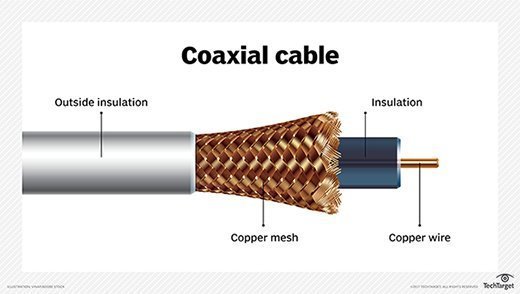What is a coaxial cable?
A coaxial cable -- or coax cable -- is a type of copper cable specially built with a metal shield and other components engineered to block signal interference.
Cable TV companies primarily use coaxial cables to connect their satellite antenna facilities to customers' homes and businesses. Telephone companies sometimes use coax cables to connect central offices to telephone poles near customers. Twisted pair cabling has largely supplanted coax's widespread use as an Ethernet connectivity medium in enterprises and data centers.
The term coaxial cable derives from its design -- it includes one physical channel that carries the signal surrounded by another concentric physical channel, both running along the same axis. The innermost channel is typically a copper wire surrounded by a layer of insulation between it and the outer channel. The outer channel serves as a ground, typically as copper mesh. Another layer of insulation surrounds both the inner and outer channels. Many of these cables or pairs of coaxial tubes can have a single outer sheathing and, with repeaters, can carry information for a great distance.
English engineer and mathematician Oliver Heaviside invented the coaxial cable in 1880. AT&T established its first cross-continental coaxial transmission system in 1940. Depending on the carrier technology -- and other factors -- twisted pair copper wire and optical fiber are alternatives to the coaxial cable.
How coaxial cables work
Coaxial cables have concentric layers of electrical conductors and insulating material. This construction ensures signals are enclosed within the cable and prevents signal interference from electrical noise.

The concentric layers of coaxial cables are as follows:
- The center conductor layer is either a solid or braided, thin copper conducting wire.
- A dielectric layer made of an insulating material with well-defined electrical characteristics surrounds the wire.
- A shield layer surrounds the dielectric layer with metal foil or braided copper mesh.
- An insulating jacket wraps the whole assembly. The coaxial cable's outer metal shield layer is typically grounded in the connectors at both ends. This shields the signals and provides a place for stray interference signals to dissipate.
Coaxial cable design depends on the cable dimensions and materials. Controlling these factors helps create a fixed value for the characteristic impedance of a coax cable. Impedance is sensitive to signal frequency. High-frequency signals are partially reflected at impedance mismatches, causing errors. Above 1 GHz, the cable maker must use a dielectric that doesn't attenuate the signal too much or change the characteristic impedance in a way that creates signal reflections.
Electrical characteristics of coax are application-dependent and crucial for good performance. Two standard characteristic impedances are the following:
- 50 ohms, used in moderate power environments.
- 75 ohms, common for connections to antennas and residential installations.
Types of coaxial cables
There are numerous types of coaxial cables, some of which include the following:
- Hard-line coaxial cables. Rely on round copper tubing and a combination of metals as a shield, such as aluminum or copper. These cables are commonly used to connect a transmitter to an antenna.
- Triaxial cables. Have a third, grounded layer of shielding to protect signals transmitted down the cable.
- Rigid-line coaxial cables. Consist of twin copper tubes that function as unbendable pipes. These lines are designed for indoor use between high-power radio frequency (RF) transmitters.
- Radiating cable. Mimics many components of the hardline cable. However, it has tuned slots in the shielding matched to the RF wavelength at which the cable operates. It is commonly used in elevators, military equipment and underground tunnels.
Types of connectors
Coaxial cables have many different types of connectors separated by two styles: plug and socket connectors. Connector types include the following:
- Bayonet Neill-Concelman. BNC connectors work with television, video signal and radio below a 4 GHz frequency.
- Threaded Neill-Concelman. TNC connectors are a threaded version of the BNC connector, used in cellphones. TNC connectors operate up to 12 GHz.
- SubMiniature version A. SMA connectors are used with cellphones, Wi-Fi antenna systems, microwave systems and radios. SMA connectors usually operate up to 18 GHz, but some can go up to 26.5 GHz.
- SubMiniature version B. Telecommunications hardware uses SMBs.
- Quick Lock SMA. QMA connectors are a quick-locking variant of SMA connectors used with industrial and communications hardware.
- Radio Corporation of America. Audio and video use RCA connectors. RCA connectors are the grouped yellow, white and red cables used with older televisions. They are also called A/V jacks.
- F connectors. Also called F-type connectors, these are used by digital and cable televisions. These commonly use RG-6 or RG-59 cables.
Coax connectors range from simple single connectors used on cable TV systems to complicated combinations of multiple thin coax links mixed with power and other signal connections and housed in semicustom bodies. These are commonly found in military electronics and avionics.
Uses of coaxial cables
Homes and small offices use short coaxial cables for cable television, home video equipment, amateur radio equipment and measuring devices. Coaxial cables are also used in automobiles, aircraft, military and medical equipment. Their primary function is to connect satellite dishes, radio and television antennae to their respective receivers.
Historically, coaxial cables were also used as an early form of Ethernet, supporting speeds of up to 10 Mbps. Since then, twisted-pair cabling has supplanted the use of coax. However, coax cables remain in use for cable broadband internet.

Coax standards
Nearly 50 distinct standards exist for coaxial cable. They are often designed for specific use cases in amateur radio or low-loss cable television. Because of widespread use in the cable television industry, RG-6 cables with double or quad shields and impedance of 75 ohms are a de facto standard for many industries. Other common coaxial specifications have an impedance of 50, 52 or 93 ohms.
Some other examples of coax standards include the following.
- RG-59/U, used for carrying broadband signal from closed-circuit TV systems.
- RG-214/U, used for high-frequency signal transmission.
Mechanical stiffness can vary tremendously, depending on the internal construction and intended use. For example, high-power cables are often made with thick insulation and are very stiff.
Some cables are deliberately made with thick center wires. This results in skin-effect resistance from high-frequency signals traveling on, not throughout, the surface of the conductor. A larger center conductor creates a stiff cable with low loss per meter.
Interference issues with coax
Coaxial cables can experience various forms of interference. Signal leakage occurs when the electromagnetic field passes through the shielding on the outside of the cable. Other times, an outside signal can leak through the insulation.
Straight-line feeds to commercial radio broadcast towers have the least leakage and interference. This is because these cables have smooth, conductive shields with few gaps in them. Interference is most significant in nuclear reactors, which need special shielding.
Difference between RG-59 and RG-6
RG-59 and RG-6 cables are commonly used in satellite television and cable modems. Older installations used the RG-59 cable before the implementation of the RG-6 cable. The RG-59 cable is thinner at a 20 American Wire Gauge (AWG) and has a copper center conductor. This cable is better for CCTV and analog video systems, so finding it in older buildings is more likely.
The RG-6 cable is a larger 18 AWG cable and has a copper center conductor. The RG-6 cable is frequently paired with high-bandwidth and high-frequency hardware, so internet and satellite signals can run at a higher frequency than traditional analog video.
Which cable an individual might need largely depends on the frequency. For requirements above 50 MHz, an individual should use an RG-6 cable.








